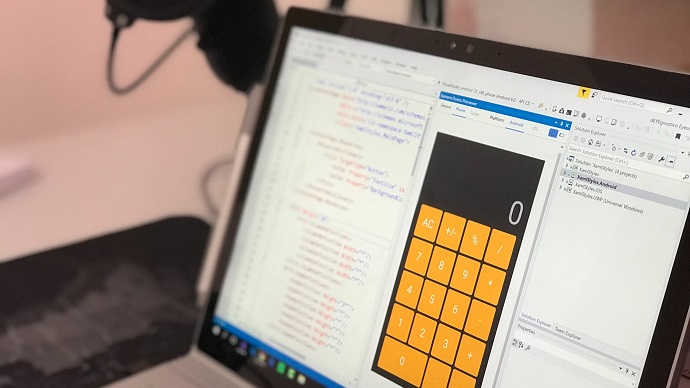
100-490: Cisco Certified Technician Routing & Switching (RSTECH)
PDFs and exam guides are not so efficient, right? Prepare for your Cisco examination with our training course. The 100-490 course contains a complete batch of videos that will provide you with profound and thorough knowledge related to Cisco certification exam. Pass the Cisco 100-490 test with flying colors.

Curriculum for 100-490 Certification Video Course
| Name of Video | Time |
|---|---|
 1. Cisco Packet Tracer Software |
16:00 |
 2. Introduction To Networks |
24:00 |
 3. Network Protocols |
19:00 |
 4. Network Access |
26:00 |
 5. Ethernet |
24:00 |
 6. Network Layer |
20:00 |
 7. Transport Layer |
16:00 |
 8. Cisco IOS |
25:00 |
 9. IP Addressing |
30:00 |
 10. White Board Practice : Subnetting |
23:00 |
 11. Lab : Basic Router Configuration |
33:00 |
 12. Lab : IPv6 Interface Configuration |
7:00 |
 13. Ideal Network |
6:00 |
| Name of Video | Time |
|---|---|
 1. Switched Networks Overview |
19:00 |
 2. Lab : Basic Switch Configuration |
21:00 |
 3. Lab : Basic Switch Port Configuration |
22:00 |
 4. VLAN |
20:00 |
 5. Routing Basics |
22:00 |
 6. Lab : Static Routing Configuration |
45:00 |
 7. Inter VLAN Routing |
10:00 |
 8. Lab : Inter VLAN Routing Configuration |
14:00 |
 9. Dynamic Routing |
30:00 |
 10. Access Control Lists |
25:00 |
 11. Lab : Access Control Lists Configuration |
10:00 |
 12. DHCP |
12:00 |
 13. NAT |
10:00 |
 14. Device Discovery & Management & Maintenance |
5:00 |
Cisco RSTECH 100-490 Exam Dumps, Practice Test Questions
100% Latest & Updated Cisco RSTECH 100-490 Practice Test Questions, Exam Dumps & Verified Answers!
30 Days Free Updates, Instant Download!
100-490 Premium Bundle

- Premium File: 67 Questions & Answers. Last update: Dec 6, 2025
- Training Course: 27 Video Lectures
- Latest Questions
- 100% Accurate Answers
- Fast Exam Updates
Cisco 100-490 Training Course
Want verified and proven knowledge for Cisco Certified Technician Routing & Switching (RSTECH)? Believe it's easy when you have ExamSnap's Cisco Certified Technician Routing & Switching (RSTECH) certification video training course by your side which along with our Cisco 100-490 Exam Dumps & Practice Test questions provide a complete solution to pass your exam Read More.
Cisco CCT 100-490 Certification: Routing and Switching Course for Network Engineers
Routing and Switching Cisco Certified Technician Program
Course Overview
The Cisco CCT Routing and Switching (100-490) course is designed to provide IT professionals with a comprehensive foundation in networking and Cisco technologies. This training is specifically aimed at individuals who want to gain practical skills in configuring, managing, and troubleshooting Cisco routers and switches. The course covers essential networking concepts, from basic topologies to advanced routing protocols, ensuring that learners gain a strong understanding of both theoretical and practical aspects of modern network infrastructure.
This course is ideal for those starting their journey in IT networking or professionals seeking to validate their knowledge and skills through the Cisco CCT certification. By following this structured training, students will not only learn the technical intricacies of Cisco devices but also understand how these devices operate in real-world enterprise networks. Participants will explore the principles of routing and switching, gain experience with hands-on labs, and develop the troubleshooting skills required to maintain efficient network environments.
The Cisco CCT 100-490 certification represents a crucial step for IT professionals who aspire to pursue advanced certifications in Cisco networking. It ensures that candidates possess a fundamental understanding of networking concepts and the ability to apply these concepts using Cisco technologies. Through this course, learners will gain insights into network architecture, device configuration, and network management techniques that are essential for building and maintaining robust IT infrastructures.
What You Will Learn from This Course
Upon enrolling in the Cisco CCT Routing and Switching (100-490) training course, participants will gain comprehensive knowledge and hands-on experience in a variety of networking areas. By the end of the course, learners will be able to:
Understand fundamental networking concepts and the role of Cisco devices in enterprise networks.
Identify different network topologies, including LANs, WANs, and hybrid networks, and determine their applications.
Configure IP addressing schemes, subnetting, and VLANs to optimize network performance and security.
Set up, configure, and manage Cisco routers and switches in both lab and production environments.
Implement static and dynamic routing protocols such as RIP, OSPF, and EIGRP for efficient packet delivery.
Apply port security, DHCP, and spanning tree protocol (STP) configurations to enhance network reliability.
Troubleshoot common network connectivity issues and resolve device misconfigurations.
Utilize Cisco tools to monitor network performance and diagnose problems effectively.
Prepare for the Cisco CCT 100-490 certification exam with confidence, using hands-on practice and theoretical knowledge.
Develop critical thinking and problem-solving skills required for network management and IT infrastructure maintenance.
This course combines theoretical explanations with practical exercises, ensuring that learners not only understand networking concepts but also gain experience in applying these concepts in real-world scenarios. By completing the modules, participants will develop the confidence to manage networks independently and prepare for more advanced Cisco certifications.
Learning Objectives
The Cisco CCT Routing and Switching (100-490) course is structured to ensure that students achieve measurable learning outcomes. The objectives are designed to provide both foundational and applied knowledge that is directly relevant to network management and certification requirements. By the end of this course, learners should be able to:
Describe the fundamental components of network architecture, including routers, switches, firewalls, and access points.
Explain the OSI and TCP/IP models and how data travels through different layers.
Analyze network topologies and determine the appropriate design for specific organizational requirements.
Assign IP addresses, calculate subnets, and implement VLANs for network segmentation and improved efficiency.
Configure Cisco devices for routing and switching tasks, ensuring secure and optimized communication across networks.
Implement and troubleshoot routing protocols, including static, RIP, OSPF, and EIGRP, for effective data forwarding.
Apply security measures to network devices, including port security, access control lists, and secure management practices.
Monitor network performance using Cisco diagnostic tools, identify bottlenecks, and implement corrective measures.
Develop troubleshooting strategies to quickly identify and resolve network issues, minimizing downtime.
Prepare systematically for the Cisco CCT 100-490 exam through structured practice labs, mock exams, and scenario-based learning.
These objectives ensure that learners not only gain knowledge but also develop practical skills essential for IT networking roles. They provide a roadmap for both study and hands-on practice, enabling students to build competence and confidence in Cisco routing and switching technologies.
Target Audience
This course is intended for a broad range of IT professionals and aspiring network engineers who are seeking to develop or validate their networking expertise. The target audience includes:
Entry-level IT professionals seeking foundational knowledge in Cisco networking and routing and switching principles.
Students and recent graduates looking to pursue a career in network administration, network engineering, or IT infrastructure management.
Network support technicians aiming to enhance their troubleshooting skills and improve their ability to manage Cisco devices.
IT professionals preparing for the Cisco CCT 100-490 certification as a step toward more advanced Cisco certifications.
Individuals responsible for maintaining enterprise networks who require a structured understanding of routing protocols, switch configuration, and network troubleshooting.
Professionals seeking practical, hands-on experience in configuring routers, switches, VLANs, and other network components.
By addressing the needs of this diverse audience, the course ensures that learners with varying levels of experience gain valuable insights and practical skills. It bridges the gap between theoretical knowledge and real-world applications, making it highly suitable for both beginners and those with some prior networking experience.
Requirements
To successfully participate in this Cisco CCT Routing and Switching (100-490) course, students should meet certain requirements that ensure they can fully engage with the course material and practical exercises. While the course is designed to accommodate beginners, the following requirements are recommended:
Access to a computer with an internet connection capable of running networking simulation software or connecting to a lab environment.
Familiarity with basic computer operations, including installing and configuring software and navigating operating systems.
A basic understanding of networking concepts, such as what a network is and how devices communicate, although this course provides comprehensive coverage of these topics.
Willingness to engage in hands-on practice using routers, switches, and simulation tools to reinforce theoretical knowledge.
Commitment to dedicating time to study and practice, as the course combines both instructional content and practical exercises.
Meeting these requirements ensures that learners can maximize the benefits of the training and gain the necessary experience to succeed in both the certification exam and real-world networking environments.
Course Description
The Cisco CCT Routing and Switching (100-490) course is an in-depth training program focused on developing the essential skills required for managing and troubleshooting Cisco networks. This course is structured into modules that cover networking fundamentals, device configuration, routing protocols, and network troubleshooting techniques. Each module combines theoretical explanations with practical exercises to provide a holistic learning experience.
Participants will start by learning about networking basics, including OSI and TCP/IP models, IP addressing, subnetting, and network topologies. These foundational concepts form the basis for understanding how data travels across networks and how different devices interact within an enterprise network environment. The course emphasizes hands-on exercises to reinforce learning, including configuring routers and switches, implementing VLANs, and managing network traffic effectively.
As learners progress, the course delves into routing and switching protocols, teaching how to configure both static and dynamic routing solutions. Students will explore protocols such as RIP, OSPF, and EIGRP, understanding their characteristics, advantages, and use cases. Practical exercises enable learners to apply these protocols in lab environments that simulate real-world networking scenarios, preparing them for challenges they may encounter in enterprise networks.
The course also emphasizes network security and troubleshooting, providing strategies to identify, diagnose, and resolve common network issues. Learners will practice using Cisco diagnostic tools and commands, gaining the skills necessary to maintain network performance and reliability. Throughout the training, emphasis is placed on real-world applications, ensuring that participants can confidently manage and optimize network infrastructure in professional settings.
Prerequisites
While the Cisco CCT Routing and Switching (100-490) course is suitable for beginners, having some prior knowledge or experience can enhance the learning experience and allow students to progress more efficiently. Recommended prerequisites include:
Basic familiarity with computer networks and internet connectivity.
Understanding of common network devices, such as routers, switches, and wireless access points.
Fundamental knowledge of IP addressing and subnetting, although detailed instruction is provided in the course.
Interest in IT networking and a commitment to hands-on learning.
Familiarity with command-line interfaces or willingness to learn basic Cisco commands.
These prerequisites are designed to ensure that learners are prepared for the course material and can engage effectively with practical labs and exercises. They also help students build a stronger foundation for the Cisco CCT 100-490 certification and future networking career growth.
Course Modules/Sections
The Cisco CCT Routing and Switching (100-490) course is structured into several detailed modules that guide learners from basic networking concepts to advanced configuration and troubleshooting techniques. Each module is designed to build upon the previous one, ensuring that students gain a strong foundation and develop practical skills relevant to real-world network environments.
The first module introduces learners to the fundamentals of network architecture, explaining the role of routers, switches, and other network devices. Students explore network topologies, the OSI and TCP/IP models, and the principles of data transmission. This module provides the knowledge necessary to understand how devices communicate within a network and lays the groundwork for hands-on configuration tasks in subsequent modules.
The second module focuses on the configuration of Cisco routers and switches. Learners gain experience in setting up devices, implementing IP addressing schemes, creating VLANs, and configuring inter-VLAN routing. The module emphasizes hands-on exercises, enabling students to practice commands and configurations in lab environments that simulate real-world networks. Topics such as port security, DHCP configuration, and spanning tree protocol are covered in depth to ensure learners can build secure and reliable networks.
The third module introduces routing protocols, including static routing, RIP, OSPF, and EIGRP. Participants learn how to configure these protocols on routers and understand the principles behind routing table creation and packet forwarding. Practical exercises allow students to implement these protocols in simulated networks, helping them gain confidence in applying routing solutions to enterprise networks.
The fourth module is dedicated to troubleshooting and network maintenance. Learners develop strategies for identifying and resolving connectivity issues, monitoring network performance, and optimizing device configurations. Hands-on labs provide real-world scenarios, including misconfigured devices, network loops, and routing inconsistencies, helping participants develop problem-solving skills critical for IT networking roles.
The final module prepares students for the Cisco CCT 100-490 certification exam. This section includes exam-focused practice labs, scenario-based exercises, and review sessions that reinforce key concepts from previous modules. By completing this module, learners are equipped with the knowledge and practical experience required to successfully pass the certification exam and apply their skills in professional network environments.
Key Topics Covered
The Cisco CCT Routing and Switching (100-490) course covers a wide range of topics essential for network management, configuration, and troubleshooting. These key topics are carefully designed to provide a comprehensive understanding of routing and switching within Cisco networks.
Networking Fundamentals: This topic covers the basics of network architecture, including the OSI and TCP/IP models, LAN and WAN topologies, and the flow of data across network layers. Learners explore how devices such as routers, switches, firewalls, and access points interact to ensure seamless connectivity.
IP Addressing and Subnetting: Students gain the skills to design and implement IP addressing schemes, calculate subnets, and allocate addresses efficiently across different network segments. This topic also introduces VLANs, which are critical for segmenting networks and enhancing security and performance.
Router and Switch Configuration: Hands-on exercises guide learners through configuring Cisco routers and switches, including basic command-line interface operations, interface setup, VLAN creation, and inter-VLAN routing. This topic emphasizes real-world scenarios where device configuration directly impacts network reliability and performance.
Routing Protocols: The course covers both static and dynamic routing protocols. Students learn the fundamentals of RIP, OSPF, and EIGRP, including configuration steps, advantages, and best use cases. The focus is on understanding how routing tables are built, how packets are forwarded, and how routers exchange information to maintain connectivity.
Switching Concepts: Learners explore key switching concepts, including MAC address tables, VLAN segmentation, port security, and the spanning tree protocol. Hands-on labs allow participants to configure switches to prevent loops, optimize traffic flow, and secure the network from unauthorized access.
Network Troubleshooting: This topic teaches strategies for identifying and resolving common connectivity issues, device misconfigurations, and routing errors. Students practice using Cisco commands and diagnostic tools to monitor network health, identify bottlenecks, and implement corrective actions efficiently.
Network Security and Optimization: Participants learn how to secure routers and switches, configure access control lists, and implement network policies that protect data and resources. Additionally, learners explore techniques to optimize network performance, including bandwidth management, traffic prioritization, and redundancy implementation.
Exam Preparation: The final key topic includes guided practice exams, scenario-based exercises, and review sessions. Learners gain familiarity with exam formats, question types, and critical concepts, ensuring they are prepared to achieve the Cisco CCT 100-490 certification.
By covering these topics comprehensively, the course ensures that students develop the skills and knowledge necessary to manage Cisco networks effectively, troubleshoot complex problems, and build a strong foundation for advanced networking certifications.
Teaching Methodology
The teaching methodology of the Cisco CCT Routing and Switching (100-490) course is designed to provide a balance between theoretical learning and hands-on practice. This approach ensures that students not only understand networking concepts but can also apply them effectively in practical scenarios.
Interactive Lectures: Each module begins with detailed lectures explaining key concepts, principles, and best practices in routing and switching. The lectures are structured to be engaging and easy to understand, breaking down complex topics into manageable sections. Real-world examples are used to demonstrate how networking concepts are applied in enterprise environments.
Hands-On Labs: Practical exercises form a core component of the training methodology. Students work with Cisco routers and switches, configuring devices, implementing VLANs, and practicing routing protocol setups. Labs simulate real-world networks, allowing learners to test their knowledge, troubleshoot issues, and gain confidence in their technical skills.
Scenario-Based Learning: Learners are presented with network scenarios that require problem-solving and decision-making. These scenarios replicate common challenges encountered in enterprise networks, including misconfigured devices, connectivity issues, and performance bottlenecks. Students develop strategies to diagnose problems and implement effective solutions.
Guided Practice: Instructors provide step-by-step guidance during lab sessions, helping learners understand configuration commands, verify device settings, and interpret network behavior. This guidance ensures that students can follow best practices and avoid common mistakes while gaining practical experience.
Collaborative Learning: The course encourages collaboration among students through group exercises, discussions, and peer review sessions. Collaborative learning allows participants to share insights, troubleshoot together, and develop a deeper understanding of networking concepts.
Self-Paced Exercises: In addition to instructor-led sessions, learners have access to self-paced exercises and simulation tools. These exercises allow students to practice configurations, explore network behavior, and reinforce learning at their own pace.
Continuous Assessment: Throughout the course, learners receive feedback on their performance in labs, exercises, and practice exams. Continuous assessment ensures that students can identify areas for improvement, consolidate knowledge, and build the confidence needed to succeed in both practical tasks and the certification exam.
This blended teaching methodology ensures that learners gain both theoretical knowledge and practical skills, providing a comprehensive learning experience that prepares them for real-world networking challenges.
Assessment & Evaluation
Assessment and evaluation are integral components of the Cisco CCT Routing and Switching (100-490) course, designed to measure learners’ understanding of concepts, proficiency in configuration tasks, and readiness for the certification exam.
Module-Based Quizzes: Each module includes quizzes to test comprehension of key topics. These quizzes assess learners’ understanding of network fundamentals, routing protocols, VLAN configuration, and device management. Quizzes provide immediate feedback, allowing students to identify areas that require further study.
Practical Labs Evaluation: Hands-on labs are assessed to evaluate learners’ ability to configure routers and switches correctly, implement routing protocols, and troubleshoot network issues. Lab evaluation focuses on accuracy, adherence to best practices, and the ability to resolve real-world network scenarios efficiently.
Scenario-Based Assessments: Scenario-based exercises test learners’ problem-solving skills in practical networking situations. Students are presented with network problems, such as misconfigured devices, connectivity failures, or routing loops, and are required to diagnose and implement solutions. These assessments develop critical thinking and prepare participants for enterprise network management tasks.
Mock Exams: Practice exams simulate the format and difficulty of the Cisco CCT 100-490 certification exam. Mock exams allow learners to gauge their readiness, identify knowledge gaps, and familiarize themselves with question types and time management strategies.
Continuous Feedback: Instructors provide ongoing feedback on quizzes, lab performance, and scenario exercises. Continuous feedback ensures that learners receive guidance on improving configuration techniques, troubleshooting strategies, and overall networking proficiency.
Final Assessment: The course culminates in a comprehensive assessment that evaluates learners’ mastery of networking concepts, practical configuration skills, and readiness for the certification exam. The final assessment combines theoretical questions, hands-on configuration tasks, and scenario-based problem-solving exercises.
Through this structured assessment and evaluation process, learners develop confidence in their technical abilities, identify areas for improvement, and gain the skills required to successfully pass the Cisco CCT 100-490 exam. The emphasis on both theoretical understanding and practical application ensures that participants are well-prepared to manage, configure, and troubleshoot Cisco networks in professional environments.
Benefits of the Course
The Cisco CCT Routing and Switching (100-490) course offers a range of benefits for IT professionals and aspiring network engineers seeking to advance their careers in the field of networking. One of the primary advantages of this course is the acquisition of a solid foundation in networking fundamentals, which includes understanding network architectures, IP addressing, subnetting, VLAN implementation, and the interaction of routers, switches, and other network devices. By building a comprehensive knowledge base, learners develop the ability to design, implement, and manage small to medium-sized enterprise networks with confidence.
Another significant benefit of this course is the hands-on experience it provides with Cisco routers and switches. Practical lab exercises allow participants to configure devices, implement routing protocols, and troubleshoot real-world network scenarios. This hands-on experience not only reinforces theoretical knowledge but also ensures that learners develop the practical skills necessary to manage live networks efficiently. By practicing in a controlled lab environment, students gain confidence in performing tasks such as inter-VLAN routing, configuring DHCP, setting up static and dynamic routing protocols, and implementing security measures on network devices.
The course also prepares learners to troubleshoot and resolve network issues effectively. Troubleshooting skills are essential for network administrators and engineers, as connectivity problems and device misconfigurations are common challenges in enterprise networks. By learning structured troubleshooting methodologies, students can identify root causes of network failures, apply corrective actions, and prevent similar issues in the future. This capability not only enhances job performance but also reduces downtime in organizational networks, which is critical for maintaining business continuity.
In addition to technical skills, the Cisco CCT 100-490 course fosters critical thinking, problem-solving, and decision-making abilities. Scenario-based exercises encourage learners to analyze network topologies, anticipate potential challenges, and implement solutions that optimize network performance and security. These soft skills are invaluable in professional networking roles, where engineers must assess complex environments, collaborate with colleagues, and make informed decisions that affect network stability and efficiency.
Certification readiness is another major benefit of the course. The training is aligned with the Cisco CCT 100-490 exam objectives, providing learners with comprehensive preparation for the certification exam. This includes practice exams, scenario-based assessments, and review sessions that reinforce key concepts. Earning the Cisco CCT certification validates a professional’s expertise in routing and switching fundamentals, enhances credibility, and can significantly improve career prospects. Certified professionals are often preferred for roles such as network administrator, support technician, and junior network engineer, and the certification serves as a stepping stone toward more advanced Cisco certifications.
Finally, the course provides long-term career benefits by opening opportunities for growth in IT networking. Professionals who complete the Cisco CCT Routing and Switching training gain a recognized qualification that enhances employability and career advancement potential. By combining theoretical knowledge, hands-on experience, and certification preparation, the course equips learners with a complete skill set for managing and optimizing enterprise networks, solving complex network problems, and contributing to organizational success. The benefits extend beyond certification, as learners gain practical expertise and confidence that can be applied immediately in professional settings.
Course Duration
The duration of the Cisco CCT Routing and Switching (100-490) course is designed to accommodate learners with varying levels of experience while ensuring comprehensive coverage of all topics required for both practical proficiency and certification preparation. Typically, the course spans several weeks, depending on the format and intensity of the training. For full-time learners, the program can be completed within three to four weeks, allowing for intensive study sessions, lab exercises, and practice assessments. For part-time learners or those balancing professional commitments, the course duration may extend to six to eight weeks, providing flexibility to study at a comfortable pace without compromising understanding.
The course is structured to provide a balanced progression of learning, starting with foundational networking concepts and gradually advancing to more complex configurations, routing protocols, and troubleshooting techniques. Each module is designed to build upon the previous one, ensuring that learners gain a coherent and integrated understanding of network operations. Time is allocated for both instructional content and hands-on lab exercises, with the majority of the course emphasizing practical application of skills on Cisco routers and switches.
In addition to scheduled instructional hours, learners are encouraged to dedicate time for self-paced study and practice. This includes reviewing lecture materials, performing additional lab exercises, and completing practice assessments. The combination of instructor-led sessions and independent practice ensures that students consolidate their knowledge and develop the proficiency required to manage networks effectively.
For those preparing for the Cisco CCT 100-490 certification, the course duration also includes targeted exam preparation sessions. These sessions focus on reinforcing key concepts, reviewing common configuration scenarios, and providing practice questions similar to those encountered in the official certification exam. By incorporating exam-focused study within the course duration, learners gain confidence and are better equipped to achieve successful certification outcomes.
Overall, the course duration is structured to provide sufficient time for comprehensive learning while allowing flexibility for individual schedules. The carefully planned timeline ensures that learners progress systematically through fundamental concepts, device configuration, routing protocols, troubleshooting strategies, and exam preparation, ultimately achieving both practical skills and certification readiness.
Tools & Resources Required
To maximize the benefits of the Cisco CCT Routing and Switching (100-490) course, learners require access to a variety of tools and resources that facilitate both theoretical learning and hands-on practice. One of the primary resources is a computer or laptop with adequate processing capabilities and network simulation software. Network simulation tools, such as Cisco Packet Tracer or GNS3, allow students to configure virtual routers and switches, create VLANs, implement routing protocols, and practice troubleshooting scenarios without the need for physical hardware. These simulators provide a realistic environment to experiment with configurations, test network designs, and understand device interactions.
In addition to simulation tools, learners benefit from access to Cisco documentation and study guides. Official Cisco resources provide detailed explanations of networking concepts, configuration commands, and protocol behaviors. These resources are essential for deepening understanding, reviewing best practices, and preparing for the Cisco CCT 100-490 certification exam. Comprehensive study guides often include step-by-step configuration examples, troubleshooting tips, and practice questions that reinforce the theoretical knowledge gained during the course.
Hands-on lab equipment, while optional for some learners, can further enhance practical skills. Physical Cisco routers and switches allow participants to experience real-world device interactions, cabling, and configuration management. Setting up lab environments with actual hardware provides exposure to physical network constraints, such as port limitations, device interfaces, and cabling topologies, which complements virtual simulations.
Access to learning platforms and online resources is also critical for continuous learning and practice. Many courses provide access to video tutorials, interactive exercises, discussion forums, and knowledge bases where learners can ask questions, share insights, and collaborate with peers. These resources support self-paced learning, provide additional practice opportunities, and allow learners to troubleshoot problems with guidance from instructors and fellow students.
Furthermore, learners should have access to basic networking tools such as cable testers, network analyzers, and diagnostic utilities if working with physical lab equipment. These tools aid in verifying connectivity, diagnosing network issues, and measuring performance, reinforcing troubleshooting skills and practical problem-solving abilities.
Finally, maintaining organized notes, configuration logs, and lab documentation is essential for tracking progress and reviewing key concepts. Documentation practices encourage systematic learning, help identify patterns in configuration and troubleshooting, and provide a reference for exam preparation and professional work. By combining simulation software, official Cisco resources, optional hardware, online platforms, and organized documentation, learners have a comprehensive toolkit that supports both theoretical understanding and hands-on mastery of Cisco routing and switching technologies.
Career Opportunities
Completing the Cisco CCT Routing and Switching (100-490) course opens a wide range of career opportunities for IT professionals and aspiring network engineers. The certification and hands-on experience gained through this course are highly valued by employers seeking skilled networking personnel who can configure, manage, and troubleshoot enterprise networks. One of the most immediate career paths is that of a network administrator, where professionals are responsible for maintaining network infrastructure, ensuring connectivity across offices or branches, and managing routers and switches for optimal performance.
Another prominent role is network support technician, where individuals assist in diagnosing network issues, configuring devices, and providing day-to-day support for enterprise networks. In this position, professionals develop practical experience in troubleshooting, monitoring network performance, and implementing network changes under supervision, building skills that are essential for more advanced networking roles.
For those aiming to grow their careers, the Cisco CCT 100-490 certification provides a stepping stone toward positions such as junior network engineer or IT infrastructure specialist. These roles require deeper knowledge of routing protocols, switching concepts, and network design principles. Professionals in these positions are often involved in implementing complex network configurations, optimizing performance, and integrating new technologies into existing network environments.
In addition, the course benefits individuals seeking to specialize in network security or network operations. Understanding routing and switching fundamentals is critical for roles that involve securing network traffic, managing firewalls, and maintaining redundancy and fault tolerance in enterprise networks. Knowledge gained from the course allows professionals to identify vulnerabilities, enforce security policies, and ensure business continuity by proactively managing network devices and configurations.
Beyond specific job titles, the Cisco CCT Routing and Switching course equips learners with transferable skills that are applicable across various industries, including IT consulting, telecommunications, education, healthcare, and finance. Organizations in these sectors rely on robust networking infrastructures, and certified professionals with practical experience in configuring and troubleshooting Cisco devices are in high demand. Completing this course enhances employability, strengthens professional credibility, and provides a solid foundation for pursuing advanced certifications, such as Cisco CCNA or CCNP, further expanding career growth opportunities.
The practical, hands-on skills developed during the course also enable professionals to take on roles involving network monitoring, optimization, and performance analysis. By mastering network diagnostic tools and troubleshooting methodologies, learners can ensure high availability, reliability, and efficiency of enterprise networks, making them valuable assets to any IT team. The combination of theoretical understanding, certification preparation, and practical experience positions graduates to excel in technical roles and pursue long-term career advancement in networking and IT infrastructure management.
Enroll Today
Enrolling in the Cisco CCT Routing and Switching (100-490) course is the first step toward advancing your networking career and achieving Cisco certification. The course provides a structured, comprehensive learning path that combines foundational knowledge, practical configuration skills, and certification exam preparation. By joining the program, learners gain access to expert-led instruction, hands-on lab exercises, scenario-based learning, and resources that support self-paced practice and continuous skill development.
Enrollment ensures that students receive guidance through every aspect of networking, from basic topologies and IP addressing to configuring routers and switches, implementing routing protocols, and troubleshooting complex network issues. The course also provides opportunities to simulate real-world scenarios, allowing learners to apply knowledge in practical environments that mirror enterprise networks. This experiential learning approach enhances understanding, builds confidence, and prepares students for professional responsibilities and the certification exam.
Prospective participants benefit from access to industry-standard tools and resources, including Cisco Packet Tracer, GNS3, and official Cisco documentation. These resources allow learners to practice configurations, explore routing and switching concepts, and reinforce troubleshooting techniques. Enrolling also provides opportunities to interact with instructors and peers through collaborative exercises, discussion forums, and guided labs, creating a rich learning environment that encourages knowledge sharing and problem-solving.
By enrolling today, learners take a proactive step toward building a recognized certification, gaining practical skills, and positioning themselves for career growth. The course is designed for flexibility, accommodating different learning styles, schedules, and experience levels. Whether you are an entry-level professional seeking to enter the networking field or an IT technician looking to validate your skills, this program provides the tools, knowledge, and support needed to succeed.
Investing in this training enhances employability, prepares participants for real-world networking challenges, and provides a strong foundation for future advanced certifications. Enroll today to start your journey toward becoming a certified Cisco professional, mastering routing and switching concepts, and achieving long-term career advancement in IT networking.
Prepared by Top Experts, the top IT Trainers ensure that when it comes to your IT exam prep and you can count on ExamSnap Cisco Certified Technician Routing & Switching (RSTECH) certification video training course that goes in line with the corresponding Cisco 100-490 exam dumps, study guide, and practice test questions & answers.
Purchase Individually



Cisco Training Courses




















Only Registered Members can View Training Courses
Please fill out your email address below in order to view Training Courses. Registration is Free and Easy, You Simply need to provide an email address.
- Trusted by 1.2M IT Certification Candidates Every Month
- Hundreds Hours of Videos
- Instant download After Registration






